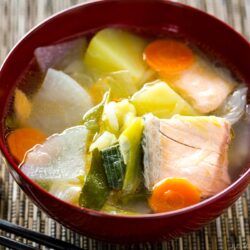
Sanpeijiru (Japanese Salmon Soup)
A popular recipe from Hokkaido, Sanpeijiru is a wonderful salted salmon soup with a variety of hearty root vegetables cooked in a kombu dashi broth. You‘ll enjoy this delicate and tasty soup on a cold day!
Ingredients
- 1 lb salmon scraps (approximately; the amount doesn‘t need to be exact; read more about salmon scraps (ara or kiriotoshi in Japanese) in the blog post)
- 3 fillets Homemade Japanese Salted Salmon
- 4 cups water
- 1 piece kombu (dried kelp) (2 x 3 inches, 5 x 8 cm per piece)
- 8 inches daikon radish
- 1 carrot
- 2 Tokyo negi (naga negi; long green onion) (or 4 scallions/green onions)
- 2 potatoes (I use Yukon gold potatoes as they don‘t break easily compared to russet potatoes)
- 4 Tbsp sake
- 1 tsp Diamond Crystal kosher salt
Instructions
- Gather all the ingredients.
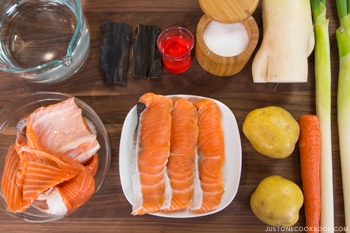
To Blanch the Salmon
- Bring a large pot of water to a boil. Cut 1 lb salmon scraps into pieces about 2–3 inches (5–8 cm).
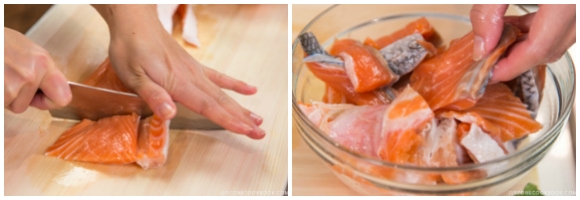
- Cut 3 fillets Homemade Japanese Salted Salmon in half crosswise.
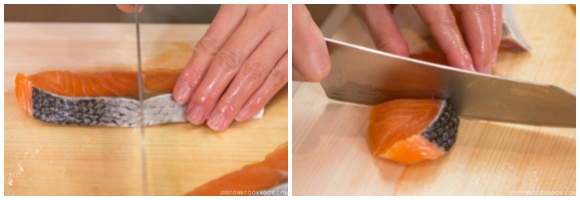
- When the water is boiling, blanch the salmon scraps and salted salmon fillets for 30 seconds. This will help get rid of the odor and remove some of the saltiness. Read my blog post about why this step is essential.
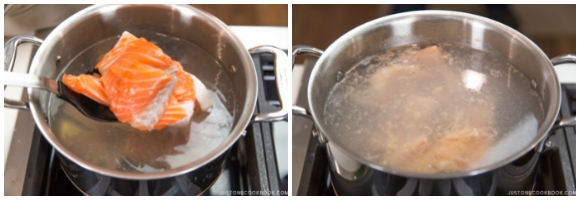
- Drain and rinse each salmon piece with water to get rid of the fat, protein (the white stuff), and sometimes scales. It’s important to get rid of the smelly oil. Read more about it in the post.
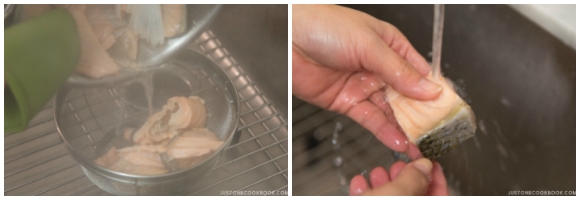
- Put all the salmon in a large pot and add 4 cups water.
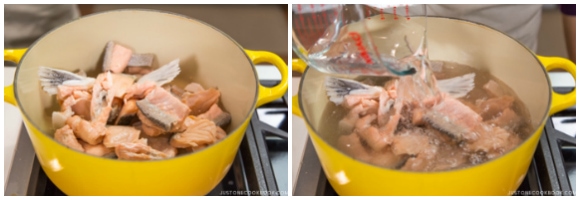
To Cook the Sanpeijiru
- Add 1 piece kombu (dried kelp) and cover with the lid. Slowly bring it to boil so that the kombu has time to release its umami.
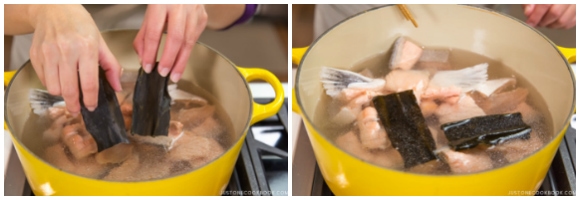
- Meanwhile, peel and cut 8 inches daikon radish in quarters lengthwise. Then, thinly cut crosswise into quarter slices.
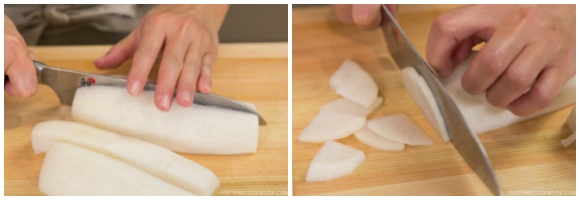
- Peel and slice 1 carrot into thin rounds (or halves or quarters, depending on the size).
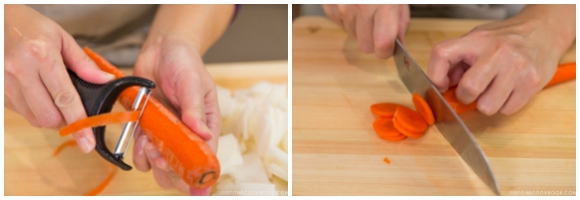
- Cut 2 Tokyo negi (naga negi; long green onion) or 4 green onion/scallions diagonally into ½-inch (1.3-cm) pieces. All the vegetables, except for the potatoes, are now ready to go.
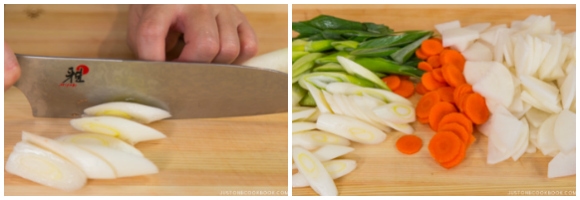
- When the soup is almost boiling, remove the kombu (you can reserve it for another use). Kombu gets slimy and releases a bitter taste in boiling water, so we remove it right before boiling. Using a fine-mesh sieve, skim the foam, fat, and scum floating on the surface of the soup. This is very important to achieve a nice, clean flavor. Some people cook the vegetables first and then add the salmon, but I prefer to cook the salmon first so it’s easier to clean the soup before adding the vegetables.
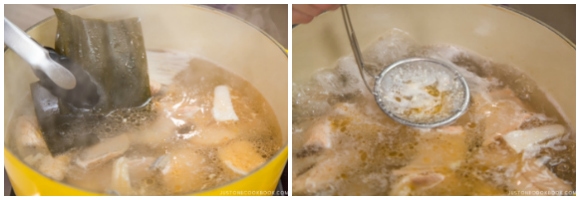
- Once the soup is clean, add the vegetables. Cover with the lid and continue to cook until the vegetables are almost tender (80% done).
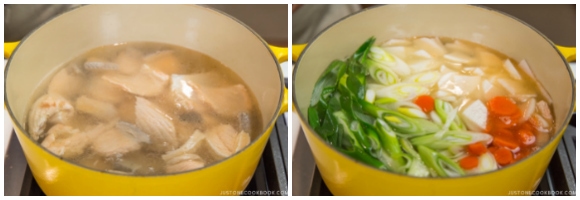
- Meanwhile, peel 2 potatoes and remove the potato eyes (sprouts) if there are any.
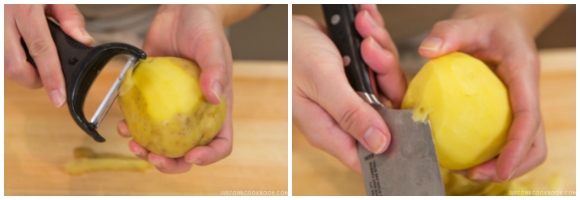
- Cut the potato into bite-size cubes (I cut each potato into 8 pieces) and soak in water to remove the starch.
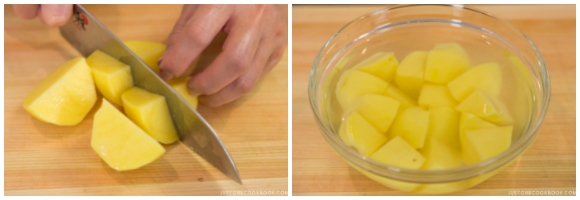
- When the daikon is semi-translucent and tender (no more raw, hard parts), add the potatoes. Continue cooking for about 15 minutes until the potatoes become tender (depending on their size).
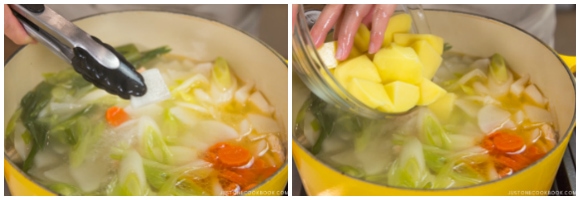
- With the fine-mesh sieve, scoop more fat and foam, if there is any.
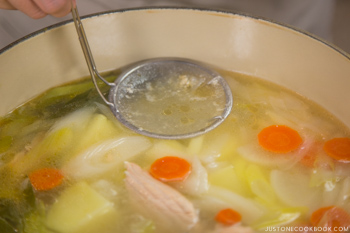
- Once the potatoes are tender, add 4 Tbsp sake and 1 tsp Diamond Crystal kosher salt. Add more salt if necessary. The saltiness depends on the salmon, so be sure to taste the soup before seasoning. Serve hot in individual bowls and enjoy!
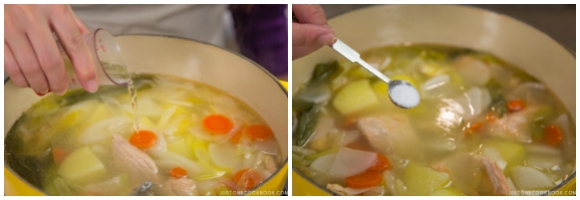
To Store
- You can keep the leftovers in an airtight container or in a pot and store in the refrigerator for up to 3 days.
Nutrition
Calories: 418kcal, Carbohydrates: 23g, Protein: 45g, Fat: 14g, Saturated Fat: 2g, Polyunsaturated Fat: 5g, Monounsaturated Fat: 4g, Cholesterol: 117mg, Sodium: 408mg, Potassium: 1633mg, Fiber: 3g, Sugar: 2g, Vitamin A: 2695IU, Vitamin C: 29mg, Calcium: 89mg, Iron: 3mg